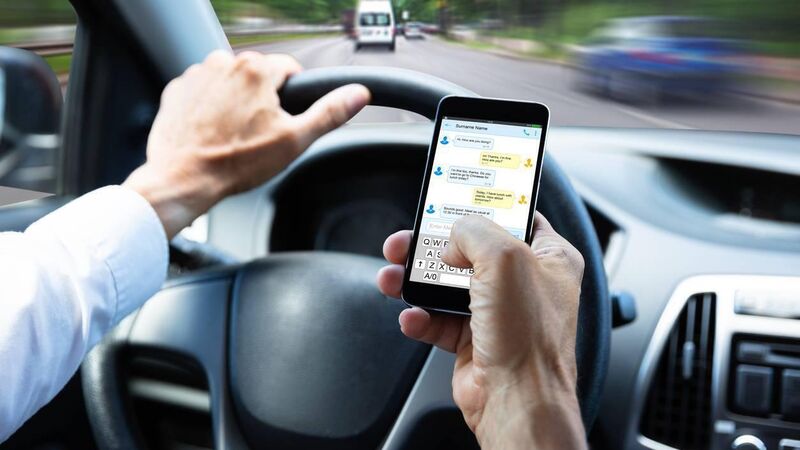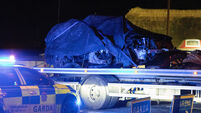Catherine Conlon: The needs of citizens must take priority over those of motorists

Medical experts have arrived at the scene of fatal road traffic accidents to find victims holding a phone.
More than 750 motorists were detected speeding on Irish roads on the Road Safety Authority (RSA) National Slowdown Day last week despite skyrocketing road deaths this year.
The mindset of many drivers to their absolute right to dominate the road space in towns, cities, and rural roads continues.
Jason van der Velde, a prehospital emergency medicine and critical care retrieval physician at Cork University Hospital, suggested that the distraction caused by our addiction to phones and the large digital display screens in modern cars is also a key issue in road deaths and that mobile phone use while driving must become socially unacceptable. Dr van der Velde reports how he has arrived at the scene of fatal road traffic accidents to find victims holding a phone.
"You can throw as much legislation at this as you’d like but until it’s socially unacceptable to interact with somebody on a phone while you’re driving it will not change," he said.
As motorists were reported to be clocking up to 194km/h on one road near Castlemartyr in East Cork and another doing 112 km/h on the main street in North Cork, while keeping an eye on their mobile phones, what is being given sparse attention is the impact that the predominance of motorised transport on streets and roads has on the ability of everyone else to move around.
The perception that the motorist has absolute priority on the roads is one that has grown over decades since car ownership has become ubiquitous.
The RSA perpetuates this widely-held perception. In its leaflet offering safety advice to parents when walking their children to school, the RSA states that "research shows that children under 12 should not cross roads on their own. They cannot decide how far away a car is or how fast it is going". Really? Does this mean that children who are in their 12th year cannot leave their house to visit their friends or run around to the local shop for milk or bread? Or even walk to school on their own?
Dublin Cycling Campaign in a widely circulated translation of the leaflet suggests that this advice should be rewritten to place the onus on drivers where, they suggest, it belongs.
"Research shows that adults should not operate motor vehicles if they cannot avoid knocking down children."
Instead of RSA advice for children to wear high visibility clothing when out walking, the advice could be "motorists should focus on the road ahead and not be distracted by their mobile phone".
Instead of advising that parents assess their child’s understanding by asking them to bring you across the road, the advice could be "after some weeks, ask your children how much they enjoy walking or cycling to school". The suggestion being made by the Dublin Cycling Campaign is for the RSA leaflet to be reshaped to support the rights of children to independent active movement in their own community.
This ability for children and young teens to be able to move freely and independently around their towns and cities has never been more vital — something that we consistently underestimate.
Social psychologist Johnathan Haidt in his new book, , describes the well-intentioned but disastrous shift towards overprotecting children and restricting their autonomy in the real world that began in the late 1980s.
"Children need a great deal of free play to thrive. The small scale challenges and setbacks that happen during play are like an inoculation that prepares children to face much larger challenges later Unsupervised play declined at the same time that the personal computer became more common and more inviting as a space for spending more free time."
Who doesn’t remember spending hours in the local park with a book, playing rounders, climbing trees, or roller-skating up and down your street with local kids, completely unsupervised by parents or carers? Where have those days gone?
That freedom was lost with the predominance of cars that literally shoved kids, and everyone else, off roads as they clogged up streets and rat-raced through estates to chop a few seconds off travel times.
One city that is streets ahead of almost every other is Barcelona. Visiting my son last week in this beautiful and densely-packed, sunshine-filled city, I got to see for myself the value of giving the streets back to the people to win its war on cars.
The plan is to install 503 superblocks right across the city by 2030 and to turn all the major avenues into walking areas.
It’s bold, wildly ambitious, and happening. I walked through tree-lined streets, planted with beds of lavender and hibiscus, chairs and tables for older people to meet and chat, flat boulders for teenagers to congregate, octagonal openings between street corners — traffic-free for kids to play ping-pong or kick a ball. Traffic does not enter these densely packed apartment-filled blocks and corners — all filled with people, dogs, birds, bees, chatter, and dappled sunshine.
Superblocks involve nine blocks on a 3 x 3 grid. The inner streets are closed to cars with traffic diverted to the outer streets. That’s it — a superblock — an island of walking space, green and quietness without any claims on extra land.
Mini-blocks can also be created — pedestrianising all the spaces between four blocks or even just two blocks. The objective is that all the inner streets are pedestrianised.
In 2017, a superblock was implemented in the neighbourhood of Sant Antoni. Before and after quality of life measures show the superblock's effect just two years after implementation.
Along with air and noise pollution reductions, perhaps most important was the traffic reduction (-92%) with no substantial increase in traffic in neighbouring streets (+3%). The technical term is that cars ‘evaporated’: people chose not to use them as often.
But these impacts can be achieved without superblocks. The Avinguda Meridiana is one of three major avenues connecting Barcelona’s city centre to the outskirts. It’s a massive six-lane urban highway. The plan from the Superilla Barcelona (the office leading Barcelona’s urban revolution) is to convert this nasty highway into a ‘rambla’ (a walkable path) in the centre with two car lanes on each side, bicycle lanes and very wide street level pavements. The street is instantly converted into a liveable breathable social space with all the same benefits of noise reduction, improved air quality, and safety for kids and adults alike.
As Cork city enters a critical phase over the next two decades, with a population that will grow by 50% to 60%, there are plans to build a transformative metropolitan transport system, housing, ambitious cycling and walking infrastructure and significant urban renewal.
How that change is managed and received by Cork citizens will influence both economic development and quality of life for all those who live, work, socialise, sleep, and play in the city.
It is an exciting time and one that warrants massive ambition in ensuring that the needs of all its citizens, young and old alike, are centrally positioned at the very heart of that vision.












